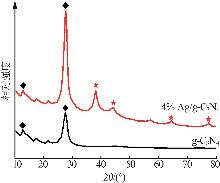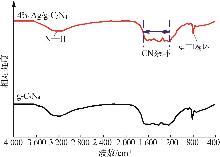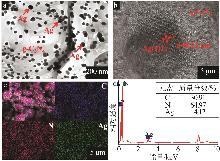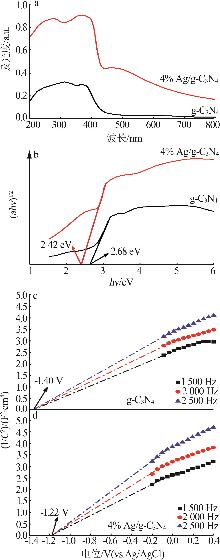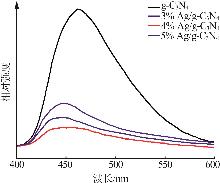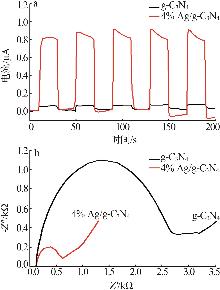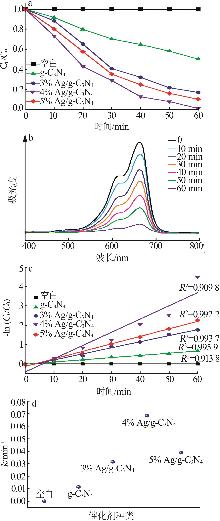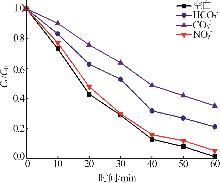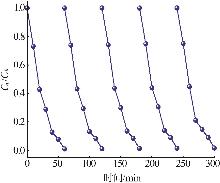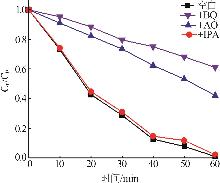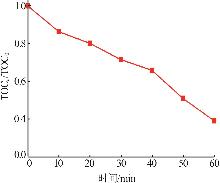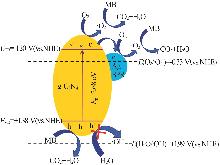Inorganic Chemicals Industry ›› 2025, Vol. 57 ›› Issue (6): 114-122.doi: 10.19964/j.issn.1006-4990.2024-0399
• Catalytic Materials • Previous Articles Next Articles
Study on preparation and visible light degradation performance of g-C3N4 loaded nano-Ag composites
ZHAO Yanyan( ), TIAN Zhuangzhuang
), TIAN Zhuangzhuang
- ChinaSias University,Zhengzhou 451150,China
-
Received:2024-07-10Online:2025-06-10Published:2024-08-28
CLC Number:
Cite this article
ZHAO Yanyan, TIAN Zhuangzhuang. Study on preparation and visible light degradation performance of g-C3N4 loaded nano-Ag composites[J]. Inorganic Chemicals Industry, 2025, 57(6): 114-122.
share this article
Table 1
Comparison of photocatalytic properties of different photocatalytic composites"
| 材料 | 光源 | 光照时间/min | 污染物 | 污染物浓度/(mg·L-1) | 催化剂投加量/mg | 降解效果/% |
|---|---|---|---|---|---|---|
| 4% Ag/g-C3N4 | 可见光 | 60 | 亚甲基蓝 | 150 | 5 | 98.9 |
| Ag/g-C3N4[ | 可见光 | 60 | 磺胺甲基嘧啶 | 2.6 | 5 | 97.3 |
| Ag/g-C3N4[ | 可见光 | 90 | 罗丹明B | 10 | 10 | 99.4 |
| Ag-P/g-C3N4[ | 可见光 | 120 | 亚甲基蓝 | 10 | 100 | 63.0 |
| g-C3N4/Ag3PO4[ | 可见光 | 110 | 亚甲基蓝 | 10 | 20 | 96.82 |
| g-C3N4/TiO2[ | 太阳光 | 180 | 罗丹明B | 20 | 100 | 98.86 |
| g-C3N4/CoFe2O4[ | 可见光 | 150 | 亚甲基蓝 | 10 | 100 | 97.40 |
| 1 | LIN Qing, SHENG Mingnan, HE Yuxin,et al.Facile fabrication of Zn-doped CuAl2O4 nanofiber membranes for photocatalytic degradation of dye wastewater[J].Applied Physics A,2024,130(6):444. |
| 2 | JIANG Bo, FENG Shanghua, ZHANG Jianping.The adsorption and regeneration of magnetic modified bentonite composite for dye wastewater[J].Key Engineering Materials,2022,905:338-343. |
| 3 | ZHU Shiyun, XU Jun, WANG Bin,et al.Highly efficient and rapid purification of organic dye wastewater using lignin-derived hierarchical porous carbon[J].Journal of Colloid and Interface Science,2022,625:158-168. |
| 4 | CHEN Genqiang, WU Yinhu, TAN Yujun,et al.Pretreatment for alleviation of RO membrane fouling in dyeing wastewater reclamation[J]. Chemosphere,2022,292:133471. |
| 5 | ZHOU Kaishan, YU Han, LI Qiao,et al.Application of phosphomolybdate/tungsten disulfide composites in the adsorption and photocatalytic degradation of dyeing wastewater[J].Separation and Purification Technology,2024,330:125431. |
| 6 | LIU Guangbing, ZHANG Han, HUANG Jincan,et al.Treatment of printing and dyeing wastewater using Fenton combined with ceramic microfiltration membrane bioreactor[J].Biochemical Engineering Journal,2024,201:109143. |
| 7 | YAN Boting, DAI Yiming, XIN Lili,et al.Research progress in the degradation of printing and dyeing wastewater using chitosan based composite photocatalytic materials[J].International Journal of Biological Macromolecules,2024,263(Pt 2):130082. |
| 8 | AAAAS M J, MOHAMED R, Al-SAHARI M,et al.Optimizing FeCl3 in coagulation-flocculation treatment of dye wastes[J].Songklanakarin Journal of Science and Technology,2021,43(4):1094-1102. |
| 9 | NGUYET P N, WATARI T, HIRAKATA Y,et al.Adsorption and biodegradation removal of methylene blue in a down-flow hanging filter reactor incorporating natural adsorbent[J].Environmental Technology,2021,42(3):410-418. |
| 10 | BARZEGAR M H, SABZEHMEIDANI M M, GHAEDI M,et al.S-scheme heterojunction g-C3N4/TiO2 with enhanced photocatalytic activity for degradation of a binary mixture of cationic dyes using solar parabolic trough reactor[J].Chemical Engineering Research and Design,2021,174:307-318. |
| 11 | XU Jiahui, MA Shuyi.High-efficiency photocatalytic degradation of RhB by protonation of g-C3N4 with Ag-loaded TiO2 nanofibers[J].Journal of Crystal Growth,2023,617:127290. |
| 12 | 孙海杰,程圆,田源,等.BiOI/g-C3N4催化剂的制备及其光催化降解罗丹明B性能[J].无机盐工业,2023,55(8):36-44. |
| SUN Haijie, CHENG Yuan, TIAN Yuan,et al.Preparation of BiOI/g-C3N4 catalyst and its photocatalytic degradation performance of Rhodamine B[J].Inorganic Chemicals Industry,2023,55(8):36-44. | |
| 13 | SONG Minggao, LI Mingchun, LI Huifeng,et al.Novel through-holes g-C3N4/BiOBr S-scheme heterojunction:Charge relocation mechanism and DFT insights[J].Surfaces and Interfaces,2023,41:103227. |
| 14 | ZHANG Lin, YU Liu, PENG Junyang,et al.Highly sensitive and simultaneous detection of ascorbic acid,dopamine,and uric acid using Pt@g-C3N4/N-CNTs nanocomposites[J].Science,2024,27(3):109241. |
| 15 | DAI Yangyang, FANG Tian, LI Shumin,et al.Mixed-matrix membranes based on semi-oxidation MXene modified g-C3N4 nano-sheet for enhanced CO2 separation[J].Separation and Purification Technology,2024,348:127776. |
| 16 | LI Chuanhao, YANG Qiaoyu, SONG Tong,et al.P/S-g-C3N4 nanosheet composites with enhanced photocatalytic water splitting and dye degradation[J].Journal of Alloys and Compounds,2024,973:172962. |
| 17 | 唐贝.ZnO/g-C3N4异质结光催化材料的制备及对吡啶的降解[J].无机盐工业,2024,56(4):133-142. |
| TANG Bei.Preparation of ZnO/g-C3N4 heterojunction photocatalytic material and its degradation of pyridine[J].Inorganic Industry Chemicals,2024,56(4):133-142. | |
| 18 | ZHENG Minjie, JIANG Aiyue, CAI Yujuan,et al.Synergistic effects of Au/g-C3N4/montmorillonite composite nanocatalysts for enhanced photocatalytic performance with visible light illumination[J].Journal of Nanoparticle Research,2023,25(5):87. |
| 19 | GUO Zhiying, DAI Fangxu, YIN Huixiang,et al.The dual role of Au nanoparticles in the surface plasmon resonance enhanced photocatalyst Au/g-C3N4 [J].Colloid and Interface Science Communications,2022,48:100615. |
| 20 | POTAPENKO K O, CHEREPANOVA S V, KOZLOVA E A.A new strategy for the synthesis of highly active catalysts based on g-C3N4 for photocatalytic production of hydrogen under visible light[J].Doklady Physical Chemistry,2023,513(1):167-175. |
| 21 | LIN Qing, GUO Xiaobei, FU Hailuo,et al.Fabrication and enhanced visible photocatalytic activity of AuPt@g-C3N4 foam[J].Materials Letters,2023,341:134194. |
| 22 | SIVAKUMAR S, THANGADURAI T D, NATARAJ D.Role of interfacial AuNPs in solid-state direct Z-scheme MoS2/Au/g-C3N4 heterojunction nanocomposite′s pollutant degradation activity under sunlight[J].Colloids and Surfaces A:Physicochemical and Engineering Aspects,2023,667:131365. |
| 23 | WU Shuisheng, YI Bing, LAN Donghui.Fabrication of Bi2MoO6/g-C3N4 visible-light driven photocatalyst for enhanced tetracycline degradation[J].Journal of Photochemistry and Photobiology A:Chemistry,2023,444:115013. |
| 24 | XU Man, LUO Yongping, ZENG Linsheng,et al.Ag/g-C3N4 nanosheets as a progressive support of Pt catalyst for improved electrocatalytic oxidation of methanol[J].Journal of Materials Science,2024,59(8):3573-3584. |
| 25 | 汲畅,王国胜.Ag3PO4/g-C3N4异质结催化剂可见光降解黄连素[J].无机盐工业,2022,54(4):175-180. |
| JI Chang, WANG Guosheng.Degradation of berberine by visible light over Ag3PO4/g-C3N4 heterojunction catalyst[J].Inorganic Chemicals Industry,2022,54(4):175-180. | |
| 26 | ZHANG Guangxin, LI Shilin, JIANG Huifang.Facile method for improving the catalytic performance of g-C3N4 by electrostatic self-assembled with Bi2MoO6/kaolinite composite[J].Materials Letters,2023,347:134594. |
| 27 | ZHANG Shixian, RONG Xinshan, SUN Ting,et al.Construct vacancy nitrogen controllable Z-scheme 3D porous g-C3N4/CoFe2O4 composite material for high-efficient photofixation nitrogen[J].Diamond and Related Materials,2023,138:110167. |
| 28 | OMRANI N, NEZAMZADEH-EJHIEH A.A comprehensive study on the mechanism pathways and scavenging agents in the photocatalytic activity of BiVO4/WO3 nano-composite[J].Journal of Water Process Engineering,2020,33:101094. |
| 29 | CHEN Xiaoxue, YU Fengqiu, GONG Fuzhong,et al.Preparation of 3D porous CeO2/g-C3N4 photocatalyst via facile one-step calcination for rapid removing of tetracycline[J].Vacuum,2023,213:112090. |
| 30 | CAO Yanbo, DONG Weiwei, YE Yanpeng,et al.Microflower-like NiFe layered double hydroxide @ g-C3N4 electrocatalysts for enhanced photo-assisted OER and overall water splitting performance[J].Journal of Alloys and Compounds,2024,996:174752. |
| 31 | DU Xing, LIU Qianqian, CHENG Miao,et al.Single-atom Pt decorated g-C3N5 nanorods as highly efficient photocatalyst for H2 evolution and wastewater purification[J].International Journal of Hydrogen Energy,2024,53:353-363. |
| 32 | MENG Xue, ZHENG Huihui, QI Yanling,et al.Three-dimensional calcium alginate hydrogel beads-entrapped g-C3N4/Ag composites for enhanced photocatalysis under LED irradiation[J].Materials Science in Semiconductor Processing,2024,180:108541. |
| 33 | 宋亚丽,李帅斌,李紫燕,等.Ag/g-C3N4复合材料可见光降解磺胺甲基嘧啶的效能及机理研究[J].轻工学报,2021,36(6):102-109. |
| SONG Yali, LI Shuaibin, LI Ziyan,et al.Degradation effect and mechanism of sulfamerazine by Ag/g-C3N4 under visible light irradiation[J].Journal of Light Industry,2021,36(6):102-109. | |
| 34 | XUE Jinbo, MA Tao, SHEN Qianqian,et al.A novel synthesis method for Ag/g-C3N4 nanocomposite and mechanism of enhanced visible-light photocatalytic activity[J].Journal of Materials Science:Materials in Electronics,2019,30(16):15636-15645. |
| 35 | 艾兵,张腾,马志,等.Ag-P改性g-C3N4的可见光催化活性研究[J].贵金属,2023,44(4):14-19. |
| AI Bing, ZHANG Teng, MA Zhi,et al.Study on visible light catalytic activity of Ag-P modified g-C3N4 [J].Precious Metals,2023,44(4):14-19. | |
| 36 | 张小芳,王盼,郭世巧,等.g-C3N4/Ag3PO4复合催化剂的制备及其可见光降解罗丹明B和亚甲基蓝[J].化工新型材料,2021,49(9):271-275. |
| ZHANG Xiaofang, WANG Pan, GUO Shiqiao,et al.Preparation and visible-light photocatalytic property of g-C3N4/Ag3PO4 composite catalyst for degradation of rhodamine B and methylene blue[J].New Chemical Materials,2021,49(9):271-275. | |
| 37 | 陈彰旭,朱丹琛,傅明连.g-C3N4/TiO2复合材料制备及其处理罗丹明B研究[J].无机盐工业,2023,55(7):130-136. |
| CHEN Zhangxu, ZHU Danchen, FU Minglian.Study on preparation of g-C3N4/TiO2 composites and application for rhodamine B removal[J].Inorganic Chemicals Industry,2023,55(7):130- 136. | |
| 38 | WELDEKIRSTOS H D, MENGIST T, BELACHEW N,et al.Enhanced photocatalytic degradation of methylene blue dye using fascily synthesized g-C3N4/CoFe2O4 composite under sun light irradiation[J].Results in Chemistry,2024,7:101306. |
| [1] | LIN Shashan, WANG Xiazhong. Study on preparation of MoS2/g-C3N4 composite loaded photocatalytic concrete and its activity [J]. Inorganic Chemicals Industry, 2025, 57(6): 123-132. |
| [2] | ZHU Jianjun, LIU Peiting, HAN Wenbo, WANG Jing. Study on preparation and visible⁃light photocatalytic properties of TiO2/g-C3N4/Ag3PO4 heterojunction [J]. Inorganic Chemicals Industry, 2025, 57(5): 116-124. |
| [3] | ZHANG Dian. Degradation performance analysis of S-scheme activated carbon supported g-C3N4/TiO2 photocatalytic concrete [J]. Inorganic Chemicals Industry, 2025, 57(4): 118-127. |
| [4] | SHI Wangfang, ZHANG Yongsheng. Study on NO x degradation performance of concrete-based non-metallic boron doped nitrogen-rich carbon nitride [J]. Inorganic Chemicals Industry, 2025, 57(3): 116-123. |
| [5] | LI Zihan, ZHANG Jiaqi, LI Shizhuo, LI Xinyu, LIU Shaozhuo, WANG Yihao, HAO Yucui, LIU Jian, LI Yanhua. Study on synthesis and catalytic mechanism of CdS/g-C3N4 composite photocatalyst [J]. Inorganic Chemicals Industry, 2025, 57(3): 124-132. |
| [6] | SUN Qinghao, LI Keyan, GUO Xinwen. Study on photocatalytic benzyl alcohol oxidation coupled with hydrogen production over Pd/ZnIn2S4 nanosheets [J]. Inorganic Chemicals Industry, 2025, 57(1): 113-119. |
| [7] | LIU Guangming. Study on photocatalytic and mechanical properties of C3N5/NH2-MIL-125(Ti) modified concrete mortar [J]. Inorganic Chemicals Industry, 2025, 57(1): 120-128. |
| [8] | ZHANG Feigang, LIU Zhongli. Study on application of CuO/g-C3N4 composites in organic dye degradation and supercapacitors [J]. Inorganic Chemicals Industry, 2025, 57(1): 129-136. |
| [9] | WANG Ping, XU Rongsheng, SUN Dong, SHI Xiaohong, XU Wei, LI Mei. Study on preparation of nitrogen-doped biochar and its adsorption properties for methylene blue [J]. Inorganic Chemicals Industry, 2024, 56(9): 117-127. |
| [10] | ZHANG Guoqiang, RONG Xilin, XIAO Zhenfang, XUE Ziran, CHENG Hao, FENG Jun, LIU Quan, LU Yao, HUANG Wenyi. Study on preparation and photocatalytic properties of bagasse carbon aerogels loaded with zinc oxide nanoparticles [J]. Inorganic Chemicals Industry, 2024, 56(8): 131-138. |
| [11] | ZHANG Bangcheng, WANG Li. Preparation and adsorption properties of waste polyester⁃based activated carbon activated by ZnCl2 [J]. Inorganic Chemicals Industry, 2024, 56(7): 126-134. |
| [12] | WANG Yawen, WANG Fangfang, GENG Siyu, JU Jia, CHEN Lei, CHEN Changdong. Study on preparation and photocatalytic performance of SrTiO3-SrWO4 [J]. Inorganic Chemicals Industry, 2024, 56(7): 143-149. |
| [13] | LIU Min, HUANG Xiu, ZHANG Liyuan. Research progress of S-type heterojunction photocatalysts [J]. Inorganic Chemicals Industry, 2024, 56(7): 18-27. |
| [14] | LI Jiangpeng, ZHANG Huibin. Synergistic degradation of methylene blue by photo-Fenton and photocatalytic with 3D porous LaFeO3/CeO2/SrTiO3 [J]. Inorganic Chemicals Industry, 2024, 56(5): 141-148. |
| [15] | TANG Bei. Preparation of ZnO/g-C3N4 heterojunction photocatalytic material and its degradation of pyridine [J]. Inorganic Chemicals Industry, 2024, 56(4): 133-142. |
| Viewed | ||||||
|
Full text |
|
|||||
|
Abstract |
|
|||||
|
||
